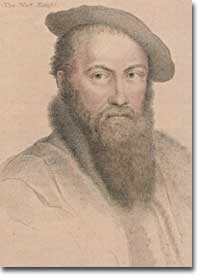Hello,
GUEST | ||||||
| ||||||
 | ||||||
 |
| Sir Thomas Wyatt, in a portrait by Hans Holbein the Younger |
The Italian Sonnet in England
The rules for the Italian sonnet were strict: 14 lines in two stanzas. The first stanza had to be 8 lines, the second 6, with some sort of turn or shift in mood between them. The pattern of end rhymes was also predetermined. Wyatt kept the most common rhyme patterns but gradually changed the structure to three quatrains (a four-line stanza) and a couplet (a two-line rhymed "clincher").
 |
| National Portrait Gallery, London, portrait by Hans Holbein |
| Henry Howard helped adapt the Italian sonnet to suit English themes and language. |
Was the strictness of the form meant to demonstrate just how desperate and eager to please the lover was? Or perhaps laboring late with quill and parchment was a kind of indulgence, a painful pleasure for the fevered lover. It seems so in this Wyatt translation of a paradoxical Petrarch Sonnet, "I Find No Peace."
I find no peace and all my war is done,Henry Howard sounds just as mixed up in his translation of a different Petrarchan sonnet, "Alas! So All Things Now Do Hold Their Peace":
I fear and hope, I burn and freeze like ice,
I fly above the wind, yet can I not arise.
...I love another, and thus I hate myself;
I feed me in sorrow, and laugh in all my pain.
Likewise displeaseth me both death and life,
And my delight is causer of this strife.
Calm is the sea, the waves work less and less;Sounds as if these poor guys need some heavy metal amplification. But back then, the tight knot of the sonnet did it for them.
So am not I, whom love, alas, doth wring,
Bringing before my face the great increase
Of my desires, whereat I weep and sing.
The Sonnet Matures
 |
| Issac Oliver |
| Sir Philip Sidney is remembered for his efforts in creating an English sonnet. But he wrote for his own amusement, and most of his poetry wasn't published in his lifetime. |
The sonnet in Shakespeare's hands would evolve so much that it came to be called the "Shakespearean" or "English" sonnet, as distinguished from the "Italian" or "Petrarchan" sonnet. And the conventional subject matter expanded to include meditations on time, beauty, poetry, rivalry, friendship, and the meaning of life.
Love, of course, was still big, but the range of moods broadened greatly as can be seen in Sonnet #29.
And then my stateNow the pallette of emotions includes intense joy, pride, disgust, and fear.
Like to the lark at break of day
From sullen earth arising, sings hymns at heaven's gate.
Before Tottel's Miscellany, English verse was a ragged, undisciplined thing — an old barrow with crooked wheels. But by the second half of the century, when Shakespeare came along, the sonnet had helped shape it into an elegant and sturdy coach that could carry his highest sentiments to his loves, and to all posterity.
BACK | LINKS | NEXT
Terms of Use | Privacy Policy
Call Toll Free 1-800-453-6227 • Fax 206-381-5601

